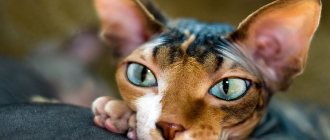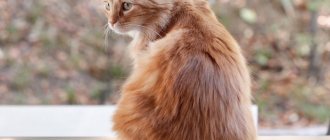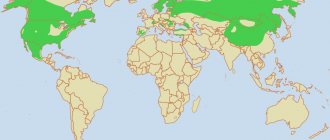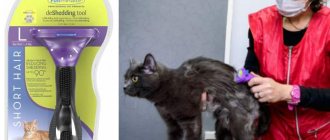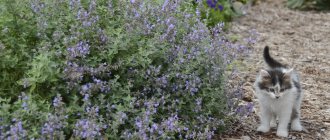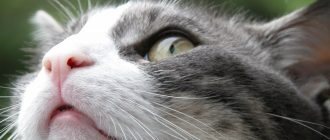The affectionate murki familiar to us are the descendants of wild predators belonging to the cat family, living next to humans for many millennia. There are more than 100 cat breeds registered in the world, among which you can find the most unusual ones - without a tail, with ears curled back, or, on the contrary, with ears curled forward, like a Scottish fold.
But a special place is occupied by cats that have tufts on their ears, like real wild lynxes. These cat breeds most closely resemble their wild ancestors and delight lovers of these animals.
general information
There are several theories about why animals need tassels on the tips of their ears:
- To amplify sound waves, which helps the animal determine not only the sources of sound, but also catch any rustles. This is important during hunting to detect the squeaking and rustling of rodents hiding under a layer of earth or snow. In addition, this quality allows you to hear the enemy, even if he is at a great distance. It is believed that without brushes, cats lose their hearing acuity.
- In order to be a kind of beacon by which animals see and recognize each other at a distance, even among dense thickets of plants.
- As an indicator of a cat's age, the longer the tassels, the more experienced and wiser the animal that has them.
Which cat has ear tufts considered normal will be discussed below.
Wild pets
Cat enthusiasts are constantly experimenting with certain wild species that have a trait they are interested in. Therefore, cats with round ears are consistently in the field of view of breeders.
Serval
African predator, lives in the northern part of the continent. It reaches one and a half meters in length, 65 cm in height and weighs up to 20 kg
Rounded large ears and beautiful spotted colors traditionally attract the attention of breeders who are engaged in breeding new breeds to the serval.
These cats show distrust of humans, do not get along well and, no matter how much care they take, remain untamed for the rest of their lives. The exception is pets that came to people at an early age, but even after reaching puberty they dramatically change their behavior.
But the servals showed their best side in parenting qualities. They easily find a common language with ordinary domestic cats and have offspring with them. Some of these hybrids have become very popular.
Savannah
A hybrid of a serval and several domestic breeds. At various stages, Oriental, Bengal cats, Ocicat and Egyptian Mau took part in the selection. The result was a large animal that inherited from its wild ancestor its height (up to 60 cm), weight (15 kg), spotted predatory coloring and large ears with round tips. A very impressive and wayward cat.
Like other hybrids of wild animals, all offspring of the Savannah are marked by blood. F1 is a direct descendant from the first mating of an African cat (50% serval). In categories F1-F4, all cats remain sterile and cannot have offspring. Therefore, only females are suitable for further reproduction.
They are bred with domestic cats (usually the Bengal breed is chosen) and continue the savannah bloodline. The F5-F7 group is represented at home. She no longer has the hunting alertness and wild aggressiveness, but all the qualities of ordinary domestic cats are manifested.
Maine Coons
The exact origin of this cat breed is not yet known. There is a version that they were brought to North America by the Vikings, another version says that it was done by one navigator. This explains their great similarity to the Norwegian forest cat breed.
The Maine Coon cat breed is one of the largest, the weight of its representatives reaches 15 kg. These cats are distinguished by long hair, large eyes and a good-natured character. A distinctive feature of Maine Coons are the charming tufts on their ears. According to one legend, the first representatives of the breed were created by crossing a domestic tabby cat with a forest lynx.
Another legend says that cats that lived on ships sailing from the port of Maine mated with local relatives of wild origin. Therefore, large specimens with pronounced tassels on their ears grew among the litter.
There is a third legend that Maine Coons were the result of crossing a raccoon with a cat. But from a genetic point of view, a litter with such mating is unrealistic.
Origin of breed characteristics
The most interesting legend about the origin of the breed concerns one ancient cat whose tail was pressed under the door due to constant lateness. This action occurred regularly, so that each new litter of kittens was born with shorter tails, until the resulting appendage was reduced to a few vertebrae.
Since then, short-tailed cats have had creases and knots on their short stumps, which they inherited from their ancestors.
The following myth classifies representatives of short-tailed breeds as descendants of the lynx family. There are indeed common features in their appearance that can convince anyone of the validity of such conclusions. Even the chromosome map of two species contains 38 elements - the most important fact from supporters of such a theory.
The next hypothesis, unlike previous stories, looks more plausible. The kittens were born with normal tails, but the mother cats chewed them off because the cubs did not fit in the cramped den.
It was by the tail that the predator could pull the kitten out of the hole. Later, a natural mutation occurred, as a result of which short-tailed breeds appeared.
And the last version, which is related to genetics. By a strange coincidence, all tailless breeds originate either on island territories or in states with a closed way of life.
Representatives of the most ancient breed of cats with a short tail - Japanese Bobtails - came to the islands from Ancient China. For several centuries they lived in isolation. Under such conditions, it is possible to launch the natural process of inbreeding (inbreeding), which can cause genetic abnormalities.
At the other end of Europe, off the coast of Ireland, on the Isle of Man, a similar story happened. Here, local cats with short tails have been known for several centuries, but they only got outside their territory at the end of the 19th century, when they represented an already established and stable group.
Pixiebob
This breed is very unusual and extremely rare. It is compared to a small domestic lynx. Despite the fact that this breed is relatively young, its origins are shrouded in mystery. There are two versions of the appearance of these cats:
- Random matings of domestic cats with short-tailed forest cats that lived in North American and Canadian forests.
- Bred artificially by felinologists. Initially, it was conceived to be similar to the American lynx, an integral part of which are the tufts on the ears.
By the way, the absence of ear tufts leads to a significant decrease in points at cat shows. Another distinctive feature of pixiebobs is their short, flexible and thick tail, which was passed on to them at the genetic level.
These unusual cats have a dog-like, loyal nature, are easy to train, and are devoted to one person in the family. These are very talkative animals, their meowing is very reminiscent of birds chirping. And they simply need company with humans, otherwise they can quickly go wild.
"Aborigines" from the Isle of Man
This is roughly the name given to the Manx cats that settled on the Isle of Man in the Irish Sea. How they got there is not known for certain, although there are many versions: from biblical to modern scientific.
Today there are 4 varieties of Manx. Depending on the length and shape of the tail, cats are divided into:
- Rampi (sacral). The tail is completely absent.
- Riser (growth). Instead of a tail, there is only a small protrusion on a couple of vertebrae. -9
- Stumpy (short). A small tail measuring 4-8 vertebrae.
- Longi (long). Quite a long tail, almost identical to the “classic” length.
- Rumpy
- Stumpy
- Riser
- Long
If we talk about character, animals are cheerful and energetic. They love active games, love to climb trees and have enviable jumping ability. The habits of cats are somewhat similar to dogs, in particular, this concerns learning various commands. Since Manx cats are very sociable, they are not recommended for people who are rarely at home.
Another distinctive feature of this breed is its excellent hunting qualities. Owners of such pets should be calm about the fact that prey in the form of mice, rats, moles and other garden and dacha “fauna” will be brought into the house. Manx cats will always find a common language with children, even when the baby is too persistent in showing his love and tormenting the cat with annoying caresses.
Norwegian Forest Cat
This is an ancient cat breed that was known back in the 16th century. There are also several legends surrounding its origin. Representatives of this breed are very similar in appearance to Maine Coons, but much smaller in size. These cats lived in Norway on animal farms and gradually moved into human homes. Their distinctive feature is a thick coat with a thick undercoat, which can protect its owner from severe cold. But besides this, it has a unique water-repellent layer, which not every cat can boast of.
Their distinct ear tufts indicate their wild origins and add to their charm. These are born hunters - they love to catch prey or imitate hunting in a game. These animals are very active and never sit still - they run, jump, and master the tops of furniture. These are very friendly and loving cats - they love affection, but at the same time they are independent. (read more about the Norwegian forest here)
Varieties
There are more than 350 species of shrews. Only 25 of them are found in Russia. The most common types of long-nosed mice are:
- Common shrew. It can reach 8 cm in length, while its weight does not exceed 160 g. The body is covered with soft brown fur. A nose with a blunt tip is clearly visible on the head. The length of the animal's tail is equal to the length of its body.
- Tiny shrew. It got its name due to its very small size. Its weight is only 3 g, and its body length is 5 cm. The animal is recognized as the smallest representative of the mammal family. His nose is like a proboscis, and his short fur is gray-brown.
- House shrew or long-tailed shrew. This mouse can often be found in the vegetable garden or garden. For the winter, she moves to cellars or basements of private houses. The body length of this long-nosed mouse is about 8 cm, and the tail is up to 5 cm.
Tiny shrew
Caracal
These cats can hardly be called pets, because they are real wild animals that have been tamed by humans. Moreover, simply catching them in the wild and taming them will not work; it requires certain skills and painstaking selection work. Only kittens born in captivity can get used to human society.
Caracals are distinguished by their charm and insane beauty. Their ears are set high and have large and bright tufts. In young representatives the bristles stand upright, while in older representatives they gradually descend. It is preferable to keep caracals not in an apartment, but in a country house. After all, these animals really need freedom and constant movement.
Canadian Sphynx
One of the oldest breeds, which has won the hearts of people with its more than extraordinary appearance - an elongated, “faceted” muzzle, bare “velor” skin, the intelligent look of lemon-shaped eyes and huge ears, like those of a bat. The first “officially described” Sphinx lived in Ancient Egypt. A white blue-eyed cat guarded the Sanctuary of Ancient Egypt.
The Don and Petersburg (Peterbald) sphinxes are also “noble eared animals” with a naked body, although they are not relatives of the “Canadians”. Both breeds were developed in Russia, and the Peterbald was created by crossing the Don Sphynx and the Oriental cat.
Hairless cats have a “dog-like disposition” and require special care. Contrary to popular belief: “no hair, no problem,” caring for Sphynx cats is more problematic than caring for Angora or Persian cats. Daily skin cleansing, strictly balanced nutrition and clothing that protects the cat from hypothermia. The Sphinx is a child in need of care with the look of a sage and the appearance of an alien creature.
Siberian cat
These animals have a fluffy and warm coat, which helped them survive in the harsh Siberian climate. After all, the ancestors of this breed are forest cats. From them they inherited wonderful tufts on their ears and long tufts of fur between their toes. Despite the long hair, this breed is considered hypoallergenic. And the fur coat has an interesting feature - a water-repellent layer, which helped these cats not freeze in the cold, snowy winter in the wild. (read more about the Siberian cat here)
Chauzie
The breed is the result of crossing an ordinary cat and a jungle cat.
Character
Shawzis are lovers of active games. They cannot stand loneliness. They willingly participate in all the affairs of family members. They are strong friends with children and can play with them for hours. Very curious and can leave the house through the window, you should be more attentive to her.
Breed characteristics and care
Chausie has short hair and a thick undercoat; The color of the animal can be silver, gold, black. Shausi's physique is strong, his muscles are well developed, his limbs are long, his paws are of medium size; The ears are large. Closer to the base they are wide, the edges are narrowed with tassels; The eyes are slanted. Specimens with light green and amber eyes can be registered in the breed; This breed only needs to be brushed during the shedding period.
Description of the breed
Maine Coon are beautiful and quite large cats, with very well developed muscles. The weight of an adult animal can reach 12 kg , but there have been cases when a cat weighed even 18 kg. These massive cats, despite their size, are very well built, they are graceful and agile.
The body of these animals is elongated, powerful, and proportional. The chest is wide, the muzzle is sharp. Strong, rounded paws set wide apart. Such cats have an unusual coat with a water-repellent undercoat and a long tail. The Maine Coon has different coat color options:
Shades not available:
- Cynamonaceae; Chocolate; Lilac; faun and pointed drawings.
